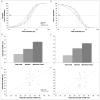Voluntary attention enhances contrast appearance
- PMID: 19254239
- PMCID: PMC2657200
- DOI: 10.1111/j.1467-9280.2009.02300.x
Voluntary attention enhances contrast appearance
Abstract
Voluntary (endogenous, sustained) covert spatial attention selects relevant sensory information for prioritized processing. The behavioral and neural consequences of such selection have been extensively documented, but its phenomenology has received little empirical investigation. We asked whether voluntary attention affects the subjective appearance of contrast--a fundamental dimension of visual perception. We used a demanding rapid serial visual presentation (RSVP) task to direct endogenous attention to a given location and measured perceived contrast at the attended and unattended locations. Attention increased perceived contrast of suprathreshold stimuli and also improved performance on a concurrent orientation discrimination task at the cued location. We ruled out response bias as an alternative account of the pattern of results. Thus, this study establishes that voluntary attention enhances perceived contrast. This phenomenological consequence links behavioral and neurophysiological studies on the effects of attention.
Figures




Similar articles
-
Voluntary attention increases perceived spatial frequency.Atten Percept Psychophys. 2010 Aug;72(6):1510-21. doi: 10.3758/APP.72.6.1510. Atten Percept Psychophys. 2010. PMID: 20675797 Free PMC article.
-
Transient covert attention and the perceived rate of flicker.J Vis. 2006 Aug 18;6(9):955-65. doi: 10.1167/6.9.8. J Vis. 2006. PMID: 17083287
-
Endogenous visuospatial attention increases visual awareness independent of visual discrimination sensitivity.Neuropsychologia. 2019 May;128:297-304. doi: 10.1016/j.neuropsychologia.2017.08.015. Epub 2017 Aug 12. Neuropsychologia. 2019. PMID: 28807647 Free PMC article.
-
Volitional covert orienting to a peripheral cue does not suppress cue-induced inhibition of return.J Cogn Neurosci. 2000 Jul;12(4):648-63. doi: 10.1162/089892900562408. J Cogn Neurosci. 2000. PMID: 10936917 Clinical Trial.
-
To look or not to look: dissociating presaccadic and covert spatial attention.Trends Neurosci. 2021 Aug;44(8):669-686. doi: 10.1016/j.tins.2021.05.002. Epub 2021 Jun 4. Trends Neurosci. 2021. PMID: 34099240 Free PMC article. Review.
Cited by
-
Reach preparation enhances visual performance and appearance.Philos Trans R Soc Lond B Biol Sci. 2013 Sep 9;368(1628):20130057. doi: 10.1098/rstb.2013.0057. Print 2013 Oct 19. Philos Trans R Soc Lond B Biol Sci. 2013. PMID: 24018719 Free PMC article.
-
Competition for visual selection in the oculomotor system.J Neurosci. 2011 Jun 22;31(25):9298-306. doi: 10.1523/JNEUROSCI.0908-11.2011. J Neurosci. 2011. PMID: 21697379 Free PMC article.
-
Enhancement and suppression in the visual field under perceptual load.Front Psychol. 2013 May 23;4:275. doi: 10.3389/fpsyg.2013.00275. eCollection 2013. Front Psychol. 2013. PMID: 23734135 Free PMC article.
-
Stimulus visibility and uncertainty mediate the influence of attention on response bias and visual contrast appearance.J Vis. 2019 Dec 2;19(14):8. doi: 10.1167/19.14.8. J Vis. 2019. PMID: 31826253 Free PMC article.
-
Investigating the phenomenological matrix of mindfulness-related practices from a neurocognitive perspective.Am Psychol. 2015 Oct;70(7):632-58. doi: 10.1037/a0039585. Am Psychol. 2015. PMID: 26436313 Free PMC article. Review.
References
-
- Anton-Erxleben K, Henrich C, Treue S. Attention changes perceived size of moving visual patterns. J Vis. 2007;7(11):51–9. - PubMed
-
- Brefczynski JA, DeYoe EA. A physiological correlate of the ‘spotlight’ of visual attention. Nat Neurosci. 1999;2(4):370–374. - PubMed
-
- Carrasco M. Covert attention increases contrast sensitivity: Psychophysical, neurophysiological, and neuroimaging studies. In: Martinez-Conde S, Macknik SL, Martinez LM, Alonso JM, Tse PU, editors. Visual Perception. Elsevier; Amsterdam: 2006. pp. 33–70. - PubMed
-
- Carrasco M. Visual attention alters appearance: Psychophysical studies of subjective experience. In: Bayne T, Cleeremans A, Wilken P, editors. Oxford Companion to Consciousness. Oxford University Press; in press.
Publication types
MeSH terms
Grants and funding
LinkOut - more resources
Full Text Sources

